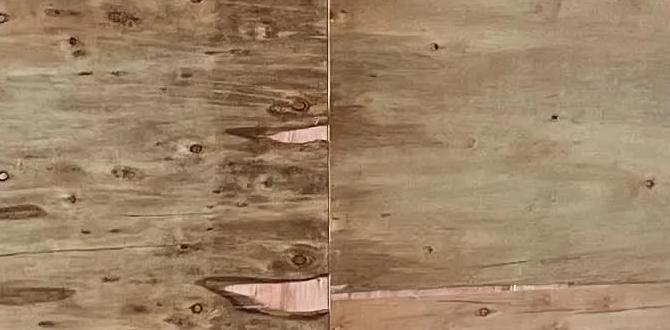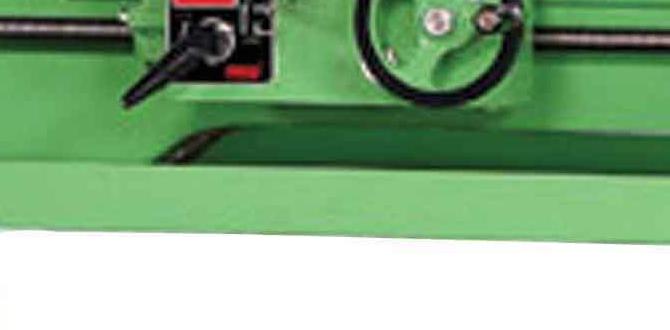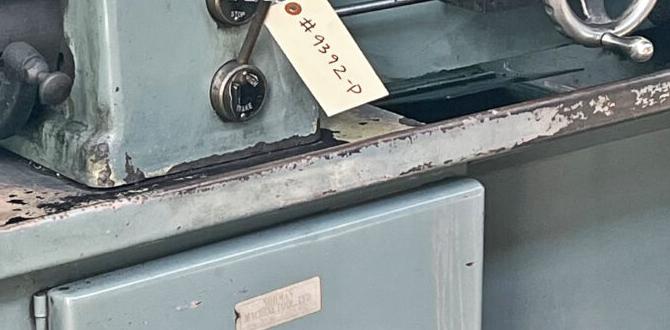Boring bars for lathes are specialized cutting tools used to enlarge or precisely finish internal diameters of workpieces. Choosing the right boring bar ensures accuracy, surface finish, and efficient material removal, preventing common machining frustrations.
Hey Makers! Daniel Bates here from Lathe Hub. Ever tried to hollow out a part on your lathe and ended up with a wobbly mess, a bad surface, or worse, a broken tool? It’s a common challenge, especially when you’re starting out. The secret to clean, accurate internal cuts often lies in the right tool: the boring bar. Don’t let the name intimidate you; understanding boring bars is simpler than you think. We’re going to break down exactly what they are, why they’re essential, and how to pick and use them like a pro. Get ready to conquer those internal diameters with confidence!
What Exactly is a Boring Bar?
At its heart, a boring bar for lathes is a slender tool designed specifically for internal machining operations. Think of it as a specialized drill bit or reamer for your lathe, but with much more control and versatility. Its primary job is to enlarge an existing hole or create a new one with high precision and a smooth finish. Unlike external turning tools that work on the outside of a workpiece, boring bars reach inside.
Why is this important? Many projects require internal features. This could be anything from creating a socket for a bearing, a fuel line passage in an engine part, or simply making a hole the exact size needed for a snug fit. Without the right boring bar, achieving accurate internal diameters can be frustrating, time-consuming, and often leads to scrap parts. They are usually held in the lathe’s tool post and extend into the workpiece.
The Core Purpose: Why Use a Boring Bar?
Boring bars aren’t just for making holes bigger; they offer a level of precision and finish quality that’s difficult to achieve with other methods. Here’s why they are indispensable:
- Precision Sizing: Boring allows you to achieve very specific internal diameters. You can adjust the tool for exact fits, which is crucial for assemblies and high-tolerance parts.
- Superior Surface Finish: Properly used, boring bars produce exceptionally smooth internal surfaces. This reduces friction and wear in moving parts.
- Straightness and Roundness: Boring ensures the hole is perfectly straight and round, centered on the workpiece’s axis. This is vital for balance and function.
- Enlarging Existing Holes: If you have a pre-drilled or cast hole that’s slightly undersized or rough, a boring bar can accurately bring it to the desired dimension.
- Creating Internal Features: Beyond simple holes, boring bars can be used to create counterbores, internal steps, and other complex internal shapes.
Types of Boring Bars for Lathes
Not all boring bars are created equal, and the type you choose will depend heavily on your material, the size of the hole, and the desired finish. Here’s a look at the most common types you’ll encounter:
1. Solid Boring Bars
These are often the workhorses for many shops. As the name suggests, they are made from a single piece of material, usually high-speed steel (HSS) or carbide.
-
Pros:
- Generally more rigid and less prone to vibration than other types.
- Simpler to use and maintain.
- Often more affordable for smaller sizes.
-
Cons:
- Limited by length; can sag if too long and slender.
- Coolant delivery can be an issue without specialized features.
- Challenging to achieve optimal cutting edge geometry for all materials.
2. Carbide Insert Boring Bars
These are incredibly popular and versatile. They consist of a bar (often steel, sometimes dedicated alloys) with a pocket or holder designed to accept replaceable carbide inserts. Carbide inserts are small, hard-cutting tips made of cemented carbide.
-
Pros:
- Interchangeable Inserts: You can easily swap inserts for different materials (steel, aluminum, plastics, brass, etc.) or different cutting geometries (roughing, finishing).
- Cost-Effective: While the initial bar might be an investment, replacing worn-out inserts is far cheaper than replacing an entire solid bar.
- Sharp Edges: Inserts are manufactured to very precise tolerances and are often sharper than what’s achievable with solid HSS.
- Easier Chip Control: Many inserts have built-in chipbreakers designed to manage chip formation.
-
Cons:
- Can be more susceptible to vibration if not properly supported or if the insert isn’t seated correctly.
- Requires purchasing a variety of inserts for different jobs.
- Jaws or clamp mechanisms can sometimes be finicky.
Carbide inserts come in various shapes and coatings. For beginners, general-purpose P-grade inserts for steel and K-grade inserts for non-ferrous materials (like aluminum and brass) are good starting points. Learn more about machining different metal grades.
3. Shank-Type Boring Bars
These are a subset of solid or insert bars where the cutting tip is integral to the bar or rigidly designed into it. They are often used for specific applications like smaller holes or where extreme rigidity is needed.
4. Adjustable Boring Bars
These bars allow for fine-tuning of the cutter position. They often use a screw mechanism to move the cutting tip in or out, allowing for very precise diameter adjustments without needing to reset the tool post too much. They can be excellent for achieving exact fits.
5. Dampened Boring Bars (Vibration-Dampening)
For very long overhangs or difficult-to-machine materials, standard boring bars can suffer from chatter and vibration. Dampened boring bars contain an internal mechanism (often a tungsten carbide weight and elastomer) that actively counteracts vibration. These are typically a premium solution for advanced users tackling challenging jobs.
Key Considerations When Choosing a Boring Bar
Selecting the right boring bar involves looking at several factors. Don’t just grab the first one you see! Here’s what to think about:
- Hole Diameter Range: This is the most critical factor. Boring bars are designed for specific diameter ranges. Too small a bar for a large hole, and it won’t reach; too large a bar for a small hole, and it won’t fit. Always check the manufacturer’s specifications.
-
Workpiece Material: Are you boring steel, aluminum, brass, stainless steel, or a plastic? Different materials require different cutting tools and speeds. Carbide inserts are usually the most versatile here.
- Steel: Typically requires HSS or coated carbide inserts with good chip control.
- Aluminum/Brass: Often benefits from sharp, polished carbide or HSS tools with no chipbreaker to allow free cutting.
- Stainless Steel: Can be tough; requires rigid tooling and specific insert grades.
- Depth of Hole / Overhang: How far does the bar need to reach into the workpiece? Longer reaches require more rigid bars to prevent deflection and vibration (chatter). If you need a lot of reach, consider a smaller diameter bar or a tool specifically designed for long overhangs.
- Required Surface Finish: For a mirror finish, you’ll want a sharp, dedicated finishing insert and slower speeds. For a general-purpose hole, a standard insert might suffice.
- Machine Rigidity: A powerful, rigid lathe can handle more aggressive cuts and larger bars. A lighter hobby lathe may require shallower cuts and more delicate tooling.
- Coolant Delivery: Some boring bars have internal coolant channels (through-spindle coolant) that feed fluid directly to the cutting edge. This is highly beneficial for cooling and chip evacuation, especially in harder materials or deeper holes.
Boring Bar Specs: What Do They Mean?
When you look at a boring bar, you’ll see numbers and descriptions. Here’s a quick rundown of the most important ones:
| Specification | Meaning | Importance for Beginners |
|---|---|---|
| Shank Diameter | The diameter of the bar that fits into the tool holder. | Must match your lathe’s tool post holder size (e.g., 1/2″, 5/8″, 3/4″ or 12mm, 16mm, 20mm). |
| Reach | The maximum distance the bar can extend from the tool holder while maintaining usable rigidity. | Crucial for determining if it can handle your part depth. Long reach needs more care. |
| Minimum Bore Diameter | The smallest hole the bar can cut into effectively. Usually related to the shank diameter plus clearance. | Ensures the bar physically fits into the starting hole. |
| Maximum Bore Diameter | The largest hole the bar can efficiently bore to. | Determines the upper limit of your boring capability with that bar. |
| Insert Type/Size | The specific code for the carbide insert or the size it accepts (e.g., CNMG, DCMT, TPMR). | Affects available geometries, coatings, and edge sizes. Start with common types like DCMT for smaller bars. |
| Material | The material of the bar itself (e.g., steel, carbide, coated carbide). | Affects rigidity and wear resistance. Carbide bars are generally more rigid but can be brittle. |
Setting Up Your Boring Bar: The Right Way
Proper setup is as crucial as having the right boring bar. A poorly set up bar will lead to poor results, regardless of its quality.
1. Secure Mounting in the Tool Post
Ensure the boring bar is held firmly in your lathe’s tool post holder. It should be perfectly vertical (or at the correct angle for your lathe’s specific setup, though vertical is standard). Some tool posts have a cylindrical bore that the boring bar fits into. Tighten the set screws securely.
2. Correct Height (Center Height) – This is CRITICAL!
The cutting tip of the boring bar MUST be set at the exact center height of the lathe’s spindle axis. This is paramount for achieving accurate diameter and a good finish. If the tip is too high, you’ll get a tapered hole and poor surface finish. If it’s too low, you’ll also get poor results and potentially damage the bar or workpiece.
- How to Set Center Height:
- Place a known-diameter rod (like a ground dowel pin or reamed hole plug gauge) in the lathe chuck, extending it out enough for you to work with.
- Bring the boring bar up to the rod.
- Use a height gauge or a precise method (like shims under the boring bar holder/tool post) to raise or lower the boring bar until its cutting edge aligns perfectly with the center of the rod.
- A common trick is to use a piece of paper or feeler gauge between the cutting edge and the rod. The edge should just barely make contact or be at the same level.
For an excellent visual guide on setting center height, check out this resource from Machining Doctor on YouTube (note: this is an external link and not part of the Lathe Hub website).
3. Setting the Cutting Edge Geometry (Insert Orientation)
For insert boring bars, ensure the insert is correctly seated and the screw or clamp holding it is tight. The sharp point of the insert is what does the cutting. Be mindful of the lead angle (the angle of the cutting edge relative to the tool shank) and how it affects chip flow and cutting forces.
4. Setting the Cutting Depth
The depth of cut will depend on your material, the tool’s rigidity, and your lathe’s power. Start conservatively! For beginners, it’s always better to take lighter cuts and multiple passes than to try and hog out material and risk tool breakage or poor finish.
Basic Boring Techniques for Beginners
Let’s get to the actual cutting. Here’s a step-by-step approach:
Step 1: Preparation
- Secure the Workpiece: Ensure your workpiece is firmly held in the chuck or between centers. Verify that it runs true.
- Install the Boring Bar: Mount the correct boring bar in the tool post, ensuring it’s at center height and securely tightened.
- Set Spindle Speed and Feed Rate: This is crucial. Consult a machining speed and feed chart for your material and tool. For HSS, speeds are slower; for carbide, much faster. Feed rate determines how much material is removed per revolution. Start conservatively, especially if you’re unsure. A feed rate that is too high can cause chatter or break the tool. A typical chart like this one from South Bend Lathes will be helpful.
- Apply Coolant: Use a cutting fluid or coolant. This lubricates the cut, cools the tool and workpiece, and helps wash away chips.
Step 2: The First Pass (Facing Cut or Starting the Bore)
If you’re starting from a solid end, you’ll likely need to drill a pilot hole first. The boring bar then follows this hole.
If you’re starting with a pre-existing hole:
- Approach the open end of the hole with the boring bar.
- Start the spindle rotation.
- Engage the feed (usually through the carriage handwheel or power feed).
- Feed the boring bar smoothly into the hole until you reach your desired depth. Listen for any unusual sounds—this could indicate chatter.
- Retract the boring bar from the hole.
Step 3: Taking Sized Cuts
The first pass is often just to clean up the bore or establish a starting size larger than your final dimension. You’ll likely need to take multiple passes to reach the exact size.
- Adjust the cross-slide or compound rest to reduce the boring bar’s diameter by a small, controlled amount (e.g., 0.010″ to 0.020″ or 0.25mm to 0.5mm). This is your depth of cut.
- Make another pass into the bore to the desired depth.
- Retract the boring bar.
- Measure the internal diameter with a micrometer or bore gauge.
- Repeat steps 1-4, taking progressively smaller cuts as you get closer to your final dimension. For extremely precise fits, your final cut might be only 0.001″ – 0.003″ (0.025mm – 0.075mm) to get a “kiss” cut.
Tip: For finishing passes, some machinists like to take a light cut and then dwell (let the tool run without feeding) for a half-turn or full turn to achieve a very smooth surface.
Step 4: Chip Management
Chips can be a real problem inside a bore. Long, stringy chips can wrap around the boring bar and tool, leading to a bad finish or broken tool. If you’re experiencing this:
- Try adjusting your feed rate and speed.
- Use a boring bar with a chipbreaker insert.
- Periodically retract the tool while still in the cut to clear chips.
- Ensure coolant is flowing effectively.
Troubleshooting Common Boring Problems
Even with the right tools and setup, issues can arise. Here are some common problems and their solutions:
| Problem | Possible Cause | Solution |
|---|---|---|
| Chatter/Vibration |
|




